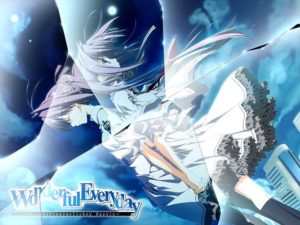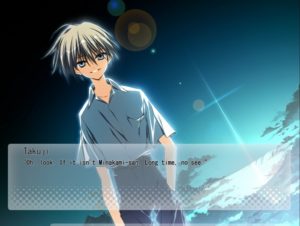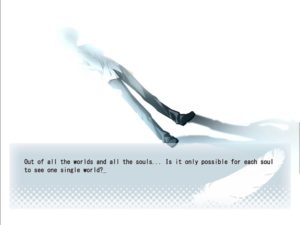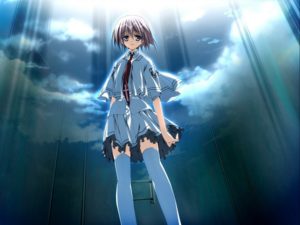This may be one of the most difficult reviews I have ever had to write as Wonderful Everyday, which I will refer to from this point forward by its abbreviation SubaHibi, is a story that very much depends on the viewer not being prepared for it. Now I have been looking forward to this game quite a bit, as word online was that it is a visual novel unlike most and delves into some rather dark themes. I backed the Kickstarter and was waiting adamantly for the the release with hope that this could be a title to add to my all time favorites. In retrospect it was the wrong way to approach this story as many overhyped the game and failed to remark on it’s rather large shortcomings. You can buy this game currently on steam but if you do so please do remember to apply a free patch to the game. The reason this is critical is that only the first chapter of the game has been put on Steam and to access the remaining six chapters this patch must be applied. The reason for this is mainly to get around Steam’s rather odd stance against pornographic content and making SubaHibi an All Ages game(Aka, removing the sex scenes) is impossible due to their importance to the story.
A question you are likely asking is what is SubaHIbi about? Answering that question for any other story would be an easy matter but here I must mind my words as I could very well spoil what may be the best part about this story. For you see SubiHibi takes an odd approach to storytelling in that the game is split up into seven chapters. Each which features a different unreliable narrator going through the strange events that took place during a two week period. The goal of SubaHibi is to take these different perspectives on the same events and piece together just what exactly happened and what caused it. As such this visual novel does not follow the standard model of having routes based on which heroine is chosen but instead follows a mostly linear route that has some small side endings. As a fan of murder mysteries I love this approach of taking stories told from different perspectives to piece together an overall narrative and was quite engaged by it. However the first chapter acts as a poor introduction to this story as it is mainly preoccupied with trying to convince you that SubaHIbi is a dime a dozen Yuri visual novel. Walking in with high expectations and reading what is equal to a fairly trashy waste of time is likely to turn many off before they get to the real story. You can argue that the first chapter holds symbolic merit upon completing the story but well you only would see that if you make it to the end of the visual novel.
To give a very vague outline on what this story is about, it is mainly a story of how a series of coincidental events can result in disastrous consequences. When it came to the story itself I got hooked on the second chapter and by the end of the third chapter I was willing to place this among my top ten visual novels. Sadly however the third chapter is the high point of this story and tells the majority of the plot. The remaining chapters act more to fill in the blanks left out in chapter three and while chapter four did still interest me, chapters five, six and seven disappointed me. That said this story is worth reading due to the highs of chapters two, three and four for it is really something to behold. Though reader beware as these chapters contain content that is not for the faint of heart. If you have made your way through the likes of Kara no Shoujo and Song of Saya then I say you would be able to stomach this. SubaHibi is a step above them in dark themes however, though it is not so much visually appalling but rather mentally sickening. SubaHibi does not hold back in any context and to some people that may be too much. That said I do respect a story that can truly go to such vile depths without it feeling too juvenile or unrealistic.
As I said above, this visual novel must be played with a patch applied which unlocks adult content and I did state that the reason the remainder of the chapters were locked behind this patch is because the adult scenes are important to the story. But I will say that the sex scenes present in SubaHibi fall into one of three categories. The necessary, the obligatory and the shock value. Necessary scenes are just that, necessary. As they show how a character was affected mentally and character development. Obligatory scenes are the standard for any visual novel as they are sex scenes shoved in for the sole purpose of meeting a quota of “All visual novels must have sex scenes”. Shock Value sex scenes are a little harder to distinguish from necessary ones as they depict scenes which are not there for titillation but rather to revolt the reader. There are some which could be argued to have story value but there are one or two that were clearly thrown in just to have the reader question just what the hell they are reading. The prime example would be one small bit of censorship on this release where a single image was cut from the game because it depited beastiality. The dialogue of the scene remains and quite frankly I am glad I didn’t have to see a visual representation of this scene. However the scene itself concerns a minor character and all it really provides is confirming that she went through a traumatic experience. Thus I find this scene to be rather weak writing only there to gross out the reader.
My disappointment in the lacking content of the last three chapters is one aspect which caused me to lower my rating on this visual novel but there is another giant problem which cause my opinion on the story to drop as a whole. Put simply, within the last three chapters a certain character is introduced and this character just brings the entire story down as a whole. She hijacks the plot and suddenly it’s all about her instead of the far more interesting elements. Not to mention the trashier elements from the first chapter come right back and are significantly worse. There are some many interesting aspects to this story but due to the inclusion of this character and everything she brings it makes it very hard for me to recommend to anyone who is not a visual novel fan or doesn’t mind such elements. I really have to question just what the author was thinking with this direction and without it’s inclusion I certainly would have a higher opinion of this visual novel as a whole. But it’s there and I just can’t ignore it due to its prevalence as the character in question does even act as a narrator for one chapter, a chapter which is the most unnecessary in the game. For a more positive turn I will remark on a certain controversy that took place before this game’s release was that an editor for fan translation went online claiming that he had not finished his second editing pass before it was taken off him. He claimed he wished to give the story another runthrough so he could add more details hinting at the overarching mystery and sadly his claims caused concern over the game’s translation quality. I do not know Japanese so I cannot truly make a judgement on the quality of the overall translation as a english only reader I thought the game read perfectly fine. I counted one typo in my entire playthrough and if the editors goal was to add more hints to the overarching mystery then I am glad he didn’t get his second pass, for the mystery is a bit too obvious as it is. At no point did I feel confused over what was going on unless it was the intended effect at the time. The story was conveyed well and really while some can debate that it could have been conveyed better, I feel this translation is more than acceptable.
In regards to visuals this artstyle does look somewhat dated due to this being a visual novel from about ten years ago. The style does have its charms in it’s simplicity though. Music is fairly passable with one or two standout tunes. A personal favorite is Ayana’s theme that matches her odd position in the plot. As for the characters I admit that there are not many that made much of an impression on me. It’s mainly the protagonists which get the most development and some have rather stereotypical anime personalities. Though some have intentionally anime like personalities while others just have them. I would say the most interesting characters outside the main protagonists would be Ayana and Kimika. Kimika shines more in her role in a side route as a resourceful though rather broken individual. Ayana makes for one of the more puzzling characters as her conversations with the protagonists very much feel like they are talking to the reader rather than the character. The writing be quite interesting when it goes into detail about philosophy and I admit it may have awakened an interest to study further into the subject myself. It is to be noted though that due to the writing dealing with such concepts it can veer into pretentious territory and your tolerance may depend on your personal interest. I found it’s early game moments of it rather thoughtful but a friend of mine found it so pretentious that it put them off reading the story altogether. As such I feel this story is going to be a love or hate affair. Let me ask this, how much value do you get out of analysing the symbolism and psychological elements of Evangelion? If your answer is a lot then you might get some milage out of this, whereas if you didn’t get anything out of Evangelions more abstract themes then you might not take a liking to this.
In conclusion I would say that if you are a visual novel fan who can handle dark themes then I would recommend checking this story out. It is deeply flawed but there isn’t really a story quite like it, be it within visual novels or even anime and manga. If you are not a fan of this medium it makes it harder to recommend but if you are feeling burned out on conventional stories then this could be something worth checking out for you. The intellectual fodder makes for some good food for thought, the overarching mystery is fascinating despite hitting it’s high point early and it goes to such dark depths that most don’t dare to venture. I am disappointed it didn’t make it into my all time favorite visual novel list but it is nonetheless a story worth experiencing.







